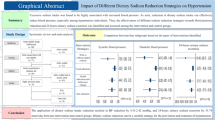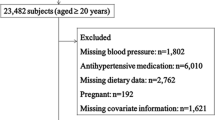Abstract
Inconsistent findings exist for the association between dietary phosphorus intake and blood pressure (BP). We examined the longitudinal association between urinary excretion and dietary intake of phosphorus (total, plant, animal, and added) with BP. This is a secondary analysis of PREMIER, a randomized behavioral intervention study in adults (25–79 years) with BP, measured at 6 months, as the primary outcome. We classified total phosphorus intake from dietary recalls into plant, animal, and added phosphorus. We modeled 6-month change of phosphorus intake (from 24 h dietary recalls, N = 622) and excretion (from 24 h urine collection, N = 564) on BP, using linear regression crude and adjusted for intervention, age, race, sex, income, education, study site, and change in energy intake (kcal/day), sodium intake (mg/day), fitness (heart rate, bpm), and DASH diet index. Baseline phosphorus intake was 1154 mg/day (95% CI 1126, 1182) with 38%, 53%, and 10% from plant, animal, and added phosphorus, respectively. Total phosphorus intake was not associated with significant changes in BP. Increased urinary phosphorus excretion was associated with a significant increase in DBP [0.14 mmHg/100 mg (0.01, 0.28), adjusted]. In several analyses, phosphorus type (plant, animal, or added) significantly modified the association between phosphorus intake and BP. For example, added phosphorus (but not plant or animal) was associated with increases in SBP and DBP, 1.24 mmHg/100 mg (0.36, 2.12) and 0.83 mmHg/100 mg (0.22, 1.44), respectively, crude. These findings suggest that the type of phosphorus may modify the association between phosphorus intake and BP. Trial registration NCT00000616 (clinicaltrials.gov).
This is a preview of subscription content, access via your institution
Access options
Subscribe to this journal
Receive 12 digital issues and online access to articles
$119.00 per year
only $9.92 per issue
Buy this article
- Purchase on Springer Link
- Instant access to full article PDF
Prices may be subject to local taxes which are calculated during checkout

Similar content being viewed by others
References
Alonso A, Nettleton JA, Ix JH, De Boer IH, Folsom AR, Bidulescu A, et al. Dietary phosphorus, blood pressure, and incidence of hypertension in the atherosclerosis risk in communities study and the multi-ethnic study of atherosclerosis. Hypertension. 2010;55:776–84. https://doi.org/10.1161/HYPERTENSIONAHA.109.143461
Elliott P, Kesteloot H, Appel LJ, Dyer AR, Ueshima H, Chan Q, et al. Dietary phosphorus and blood pressure: International study of macro- and micro-nutrients and blood pressure. Hypertension. 2008;51:669–75. https://doi.org/10.1161/HYPERTENSIONAHA.107.103747
Olivo RE, Hale SL, Diamantidis CJ, Bhavsar NA, Tyson CC, Tucker KL, et al. Dietary phosphorus and ambulatory blood pressure in African Americans: The Jackson Heart Study. Am J Hypertens. 2018. https://doi.org/10.1093/ajh/hpy126
McClure ST, Rebholz CM, Medabalimi S, Hu EA, Xu Z, Selvin E, et al. Dietary phosphorus intake and blood pressure in adults: a systematic review of randomized trials and prospective observational studies. Am J Clin Nutr. 2019;109:1264–72.
Palomino HL, Rifkin DE, Anderson C, Criqui MH, Whooley MA, Ix JH. 24-hour urine phosphorus excretion and mortality and cardiovascular events. Clin J Am Soc Nephrol. 2013;8:1202–10. https://doi.org/10.2215/CJN.11181012
Mohammad J, Scanni R, Bestmann L, Hulter HN, Krapf R. A controlled increase in dietary phosphate elevates BP in healthy human subjects. J Am Soc Nephrol. 2018;29:2089. https://doi.org/10.1681/ASN.2017121254
Yamamoto KT, Robinson-Cohen C, de Oliveira MC, Kostina A, Nettleton Ja, Ix JH, et al. Dietary phosphorus is associated with greater left ventricular mass. Kidney Int. 2013;83:707–14. https://doi.org/10.1038/ki.2012.303
Nishi T, Shuto E, Ogawa M, Ohya M, Nakanishi M, Masuda M, et al. Excessive dietary phosphorus intake impairs endothelial function in young healthy men: a time- and dose-dependent study. J Med Investig. 2015;62:167–72. https://doi.org/10.2152/jmi.62.167
Shuto E, Taketani Y, Tanaka R, Harada N, Isshiki M, Sato M, et al. Dietary phosphorus acutely impairs endothelial function. J Am Soc Nephrol. 2009;20:1504–12. https://doi.org/10.1681/ASN.2008101106
Itkonen ST, Karp HJ, Kemi VE, Kokkonen EM, Saarnio EM, Pekkinen MH, et al. Associations among total and food additive phosphorus intake and carotid intima-media thickness–a cross-sectional study in a middle-aged population in Southern Finland. Nutr J. 2013;12:94. https://doi.org/10.1186/1475-2891-12-94. PG-94
Chang AR, Lazo M, Appel LJ, Gutiérrez OM, Grams ME, Chang AR, et al. High dietary phosphorus intake is associated with all-cause mortality: results from NHANES III. Am J Clin Nutr. 2014;99:320–7. https://doi.org/10.3945/ajcn.113.073148
Gutiérrez OM, Luzuriaga-mcpherson A, Lin Y, Gilbert LC, Ha S, Beck GR. Impact of phosphorus-based food additives on bone and mineral metabolism. J Clin Endocrinol Metab. 2015;100:4264–71. https://doi.org/10.1210/jc.2015-2279
Karp H, Ekholm P, Kemi V, Hirvonen T, Lamberg-Allardt C. Differences among total and in vitro digestible phosphorus content of meat and milk products. J Ren Nutr. 2012;22:344–9. https://doi.org/10.1053/j.jrn.2011.07.004
Ravindran V, Ravindran G, Sivalogan S. Total and phytate phosphorus contents of various foods and feedstuffs of plant origin. Food Chem. 1994;50:133–6. https://doi.org/10.1016/0308-8146(94)90109-0
Lee JW, Underwood EJ. The total phosphorus, phytate phosphorus and inorganic phosphorus of bread and the destruction of phytic acid in bread making. Aust J Exp Biol Med Sci. 1949;27:99–104. https://doi.org/10.1038/icb.1948.42
Karp H, Ekholm P, Kemi V, Itkonen S, Hirvonen T, Närkki S, et al. Differences among total and in vitro digestible phosphorus content of plant foods and beverages. J Ren Nutr. 2012;22:416–22. https://doi.org/10.1053/j.jrn.2011.04.004
Lampila LE. Applications and functions of food-grade phosphates. Ann N Y Acad Sci. 2013;1301:37–44. https://doi.org/10.1111/nyas.12230
Svetkey LP, Harsha DW, Vollmer WM, Stevens VJ, Obarzanek E, Elmer PJ, et al. Premier: a clinical trial of comprehensive lifestyle modification for blood pressure control: rationale, design and baseline characteristics. Ann Epidemiol. 2003;13:462–71. https://doi.org/10.1016/S1047-2797(03)00006-1
Appel LJ, Champagne CM, Harsha DW, Cooper LS, Obarzanek E, Elmer PJ, et al. Effects of comprehensive lifestyle modification on blood pressure control: main results of the PREMIER clinical trial. J Am Med Assoc. 2003;289:2083–93. https://doi.org/10.1001/jama.289.16.2083
US Department of Agriculture, Agricultural Research Service NDL. USDA Branded Food Products Database. http://www.ars.usda.gov/nutrientdata
Lin P-H, Wang Y, Grambow SC, Goggins W, Almirall D. Dietary saturated fat intake is negatively associated with weight maintenance among the PREMIER participants. Obesity. 2012;20:571–5. https://doi.org/10.1038/oby.2011.17
Willett WC, Howe GR, Kushi LH. Adjustment for total energy intake in epidemiologic studies. Am J Clin Nutr. 1997;65:1220S–8S. https://doi.org/10.1093/ajcn/65.4.1220S
Fung TT, Chiuve SE, McCullough ML, Rexrode KM, Logroscino G, Hu FB. Adherence to a DASH-style diet and risk of coronary heart disease and stroke in women. Arch Intern Med. 2008;168:713–20. https://doi.org/10.1001/archinte.168.7.713
McClure ST, Rebholz CM, Phillips KM, Champagne CM, Selvin E, Appel LJ. The percentage of dietary phosphorus excreted in the urine varies by dietary pattern in a randomized feeding study in adults. J Nutr. 2019;149:816–23.
Morimoto Y, Sakuma M, Ohta H, Suzuki A, Matsushita A, Umeda M, et al. Estimate of dietary phosphorus intake using 24-h urine collection. J Clin Biochem Nutr. 2014;55:62–66. https://doi.org/10.3164/jcbn.14-15
Sakuma M, Morimoto Y, Suzuki Y, Suzuki A, Noda S, Nishino K, et al. Availability of 24-h urine collection method on dietary phosphorus intake estimation. J Clin Biochem Nutr. 2017;60:125–9. https://doi.org/10.3164/jcbn.16-50
Shinozaki N, Murakami K, Asakura K, Uechi K, Kobayashi S, Masayasu S, et al. Dietary phosphorus intake estimated by 4-day dietary records and two 24-hour urine collections and their associated factors in Japanese adults. Eur J Clin Nutr. 2018;72:517–25. https://doi.org/10.1038/s41430-018-0114-1
Acknowledgements
STM was supported by the NIH/National Heart, Lung, and Blood Institute grant T32 HL007024. CMR was supported by a Mentored Research Scientist Development Award from the National Institute of Diabetes and Digestive and Kidney Diseases (K01 DK107782). ES was supported by NIH/NIDDK grants K24DK106414 and R01DK089174.
Author information
Authors and Affiliations
Corresponding author
Ethics declarations
Conflict of interest
The authors declare that they have no conflict of interest.
Additional information
Publisher’s note: Springer Nature remains neutral with regard to jurisdictional claims in published maps and institutional affiliations.
Supplementary information
Rights and permissions
About this article
Cite this article
McClure, S.T., Rebholz, C.M., Mitchell, D.C. et al. The association of dietary phosphorus with blood pressure: results from a secondary analysis of the PREMIER trial. J Hum Hypertens 34, 132–142 (2020). https://doi.org/10.1038/s41371-019-0231-x
Received:
Revised:
Accepted:
Published:
Issue Date:
DOI: https://doi.org/10.1038/s41371-019-0231-x
This article is cited by
-
Phosphate intake, hyperphosphatemia, and kidney function
Pflügers Archiv - European Journal of Physiology (2022)



